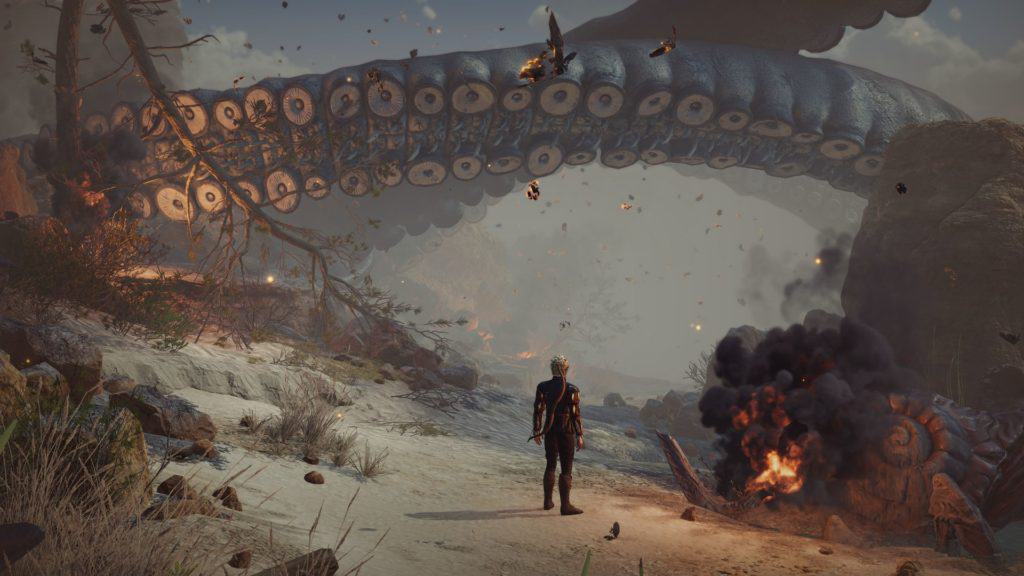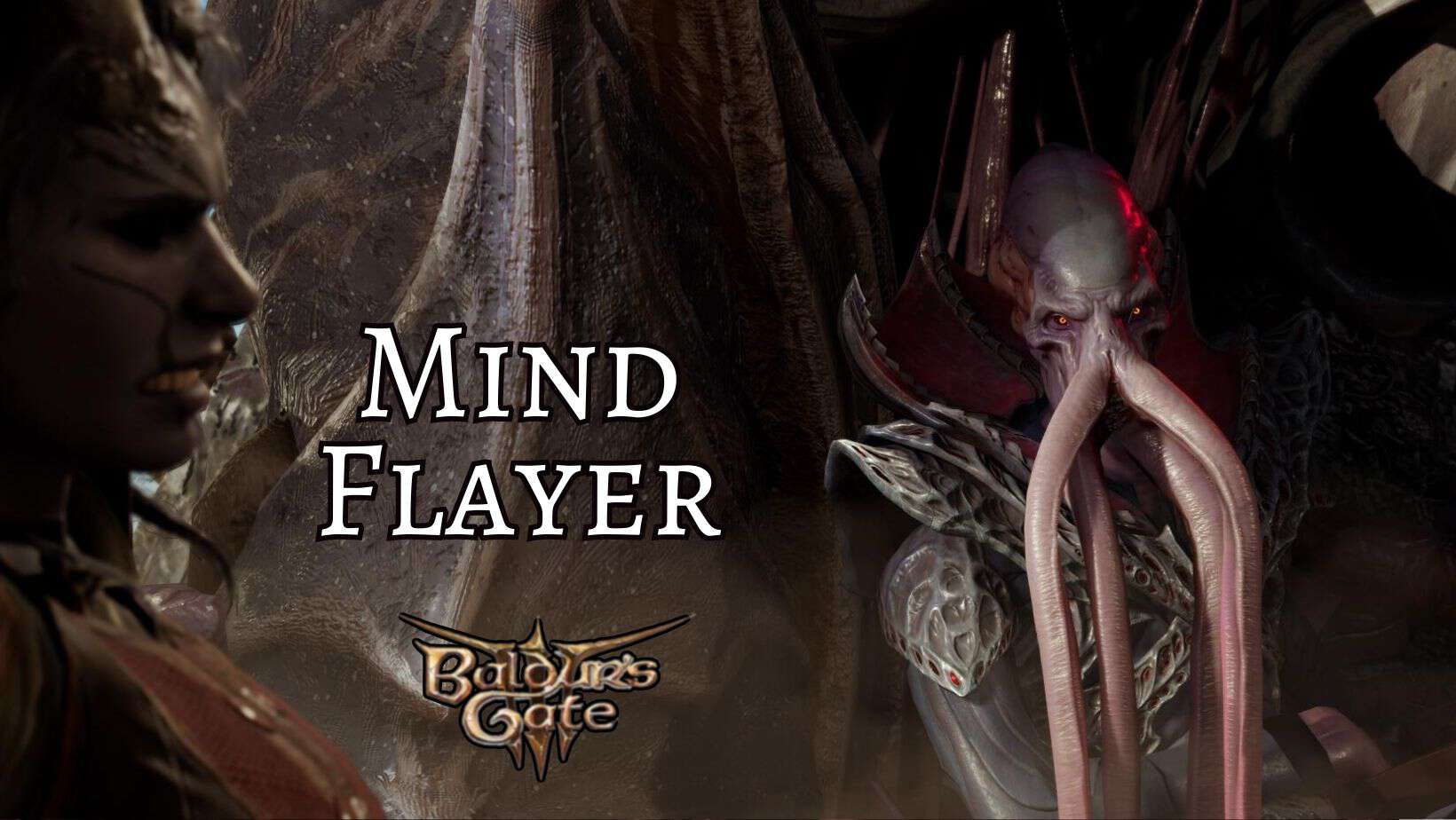Welcome, adventurers of all sorts, to a journey filled with suspense, excitement, and a dash of mind-boggling terror. Today, we plunge headfirst into the world of sinister creatures and thrilling quests, where the lines between reality and imagination often blur. Our guest of honour is one of Dungeon & Dragons’ most iconic and chilling inhabitants, the Mind Flayer, the victim of a strange metamorphosis, forming a core part of the narrative in the highly anticipated “Baldur’s Gate 3.”
As a brief reintroduction, Mind Flayers, or Illithids as some know them, make for some of the perfect antagonists in the realm of high fantasy. They boast a menacing appearance complete with humanoid bodies and octopus-like heads, and their preferred diet, the brains of sentient beings, sends shivers down even the most seasoned fighter’s spine. More than that, with the power to dominate minds, these creatures truly encapsulate the essence of horror that draws players to the game.
“Baldur’s Gate 3,” the latest addition to the highly successful Baldur’s Gate series, is a game that wonderfully marries traditional role-playing with the modern mechanics of interactive gameplay. With rich narrative arcs and meticulously designed visual aesthetics, it has garnered massive excitement among the D&D fraternity and game enthusiasts alike. It’s a digital canvas where players test their wits, strategy, and luck while clashing with powerful creatures in a world delicately balanced between chaos and order.
Our tale, however, lies at the murky intersection of the fantastical world of D&D and the rich, interactive experience offered by “Baldur’s Gate 3.” Here, the nefarious Mind Flayer has made a transition, amplified with the potential to impact, or even to dictate, the choices you, the player, make in the game. So, fasten your seatbelts, we’re about to embark on a thrilling expedition where we visit an old creature in a new haunting role.
The Mind Flayer: A Terrifying Creature
If there was to be an embodiment of nightmarish dread in the world of Dungeons & Dragons, it would undoubtedly be the Mind Flayer. These creatures possess a humanoid form draped in dark robes, but their heads bare an unsettling resemblance to an octopus, complete with writhing tentacles. Their complexions are a ghostly, alien white, and their eyes, devoid of any pupil, burn with an insidious glow of malevolence. Their appearance alone tells a tale of horror, but it is their abilities that truly cast a shadow of fear.
Mind Flayers are master manipulators, not just physically, but also mentally. They gorge on the brains of intelligent beings, voraciously harvesting the accumulated knowledge, experiences and essence of their victims. But they don’t merely assail their prey’s minds; they control and command them, using their psionic abilities to bend the will of others, turning enemies into unwilling servants. However, they are not solitary monsters; they form complex, hive-like social structures, centering around an ancient and powerful Elder Brain, to which they are all psychically linked.
Try my AI Tabletop RPG generators...and an extensive library of content!
Over the years, the Mind Flayers have claimed a unique space in the various editions of D&D, often serving the role of the inscrutable villain, the puppeteer behind a web of events that the adventurers must unravel. Be it in the dark corners of Undermountain or the alien corridors of a crashed Spelljammer ship, for many players, the sight or suggestion of a Mind Flayer is an immediate sign that they are in deep and dangerous waters.
The wider cultural impact of the Mind Flayers extends beyond the table-top. Thanks to their striking design and compellingly horrific lore, these creatures have found their way into novels, artwork and video games, consistently triumphing as one of the most iconically fearsome creatures in fantasy. Featured prominently in R.A. Salvatore’s novels, and represented in games like ‘Neverwinter Nights’, the Mind Flayer has etched itself into the annals of fantasy horror, ensuring that wherever intelligent life is to be found, its nightmares probably include these brain-devouring creatures.

Baldur’s Gate 3: A New Adventure
The road to “Baldur’s Gate 3” has been a fascinating journey through time, starting with the launch of the original “Baldur’s Gate” in 1998. Developed by BioWare, the series quickly rose to fame with its perfect blend of real-time-strategy with pause-and-play mechanisms, a tantalizing storyline, and a depth of gameplay that reverently respected the Dungeons & Dragons rule-set from which it was birthed.
Fast-forward two decades, and the magnificent city of Baldur’s Gate rises once again from the foggy past into the bright light of modern gaming. Larian Studios has taken the torch with “Baldur’s Gate 3,” bringing an array of innovations to the much-loved series. The game’s expansive world, cinematic storytelling, and complex character interactions, coupled with the refined version of the studio’s acclaimed turn-based combat system, provide players with an adventure where every decision made can swing the narrative in a different direction.
⚔️ Fantasy RPG Random Tables Books
Make life as a Gamemaster easier…
If you play Dungeons & Dragons, Pathfinder, or other fantasy RPGs, this
RPG random tables series
is packed with encounters, NPCs, treasure, and more. Available in eBook or print—either way, you’ll have a wealth of adventure ideas at your fingertips.
Drawing inspiration from the 5th Edition of Dungeons & Dragons, “Baldur’s Gate 3” allows players to experience D&D in a digital landscape molded around the tabletop game’s latest ruleset. Players can choose from a roster of D&D-inspired classes and races, and even sub-races, as they carve out their own unique place in this expansive world. Moreover, mechanics like ability checks, short and long rests, and saving throws are digitized straight out of the D&D handbook, giving players the closest possible digital realization of a D&D campaign.
“Baldur’s Gate 3” is not just a veritable playground for D&D enthusiasts but a crowning achievement in portraying how a classic pen and paper RPG can be translated effectively into a video game. By building on the solid foundation of the 5th Edition, the game provides a natural and satisfying progression from the physical table-top into the boundless digital realm, delivering a truly immersive journey that the players can embark upon.
The Mind Flayer in Baldur’s Gate 3
In “Baldur’s Gate 3,” the Mind Flayer finds a new digital playground to inflict its horrors upon unsuspecting players. True to its foreboding presence in the lore of Dungeons & Dragons, the Mind Flayer is depicted with unsettling detail and clarity in the game, radiating an aura of unease and dread every time it appears on the screen.
From the very outset of the game, the Mind Flayer initiates a haunting narrative thread. A Mind Flayer tadpole, a primordial form of the creatures, infects you and your party. This clever plot device sets up an ongoing sense of urgency, danger and intrigue as you scramble to rid yourself of this alien parasite before you’re fully transformed into a Mind Flayer yourself. Yet, Mind Flayers are not just immediate threats. They propagate an intricate web of terror and manipulation from the shadows, influencing everything from the choices you make to the factions you meet, making their presence felt throughout the game’s narrative.
Your interactions with the Mind Flayer are multifaceted, ranging from direct combat to psychological warfare. When you encounter them, their psionic powers and brain extracting tentacles present formidable challenges during combat. However, the Mind Flayers’ influence is most felt in the unique narrative interactions and choices you are forced to navigate. Given the tadpole present within you, the game presents opportunities where you can leverage its mind-controlling powers at the risk of losing more of your humanity.
In this way, “Baldur’s Gate 3” takes one of the most iconic creatures from Dungeons & Dragons and places it at the center of your story, making the game not just a battle against the forces of evil but also a struggle against the growing darkness within. The Mind Flayer in “Baldur’s Gate 3” serves as a chilling reminder of how little control we might have, and that sometimes, the greatest threat comes from within.
A Comparative Analysis
Dungeons & Dragons and “Baldur’s Gate 3” present the Mind Flayer in ways that both align with and diverge from one another, highlighting the creative tension between maintaining the source material’s authenticity and introducing new dynamics that fit within a video game format.
In both D&D and “Baldur’s Gate 3”, the Mind Flayer remains a formidable and fearsome entity. Its psionic abilities, alien appearance, and terrifying mental domination superimposed on its insatiable appetite for brains stay true across both mediums. However, while D&D often features Mind Flayers as villains to be defeated, “Baldur’s Gate 3” takes a step further. Here, the Mind Flayer transitions from a mere antagonist to an intruding presence within the player character, thereby elevating the sense of impending doom from external to internal.
The developers at Larian Studios beautifully leverage this creative liberty, injecting personal stakes into the universal threat posed by the Mind Flayers. The Mind Flayer tadpole infestation allows players to experience first-hand the insidious nature of these creatures. This innovative narrative trajectory veers from traditional confrontational encounters with the Mind Flayer in D&D to a more nuanced and intimate struggle.
While adhering to the established lore of the Mind Flayer, “Baldur’s Gate 3” also contributes to it. For instance, the game elucidates on the Mind Flayer process of Ceremorphosis with haunting visual detail, providing players a firsthand experience of this horrifying transformation, thus expanding on an aspect of Illithid biology that was previously only in the realm of lore and imagination.
The depiction of the Mind Flayer in “Baldur’s Gate 3” and its roots in D&D’s foundation convey a harmony between the preservation of sacred RPG lore and adaption to the dynamic needs of modern gaming narratives, demonstrating how fantasy storytelling continues to evolve and adapt in surprising and horrifyingly delightful ways.
⚔️ Fantasy RPG Random Tables Books
Make life as a Gamemaster easier…
If you play Dungeons & Dragons, Pathfinder, or other fantasy RPGs, this
RPG random tables series
is packed with encounters, NPCs, treasure, and more. Available in eBook or print—either way, you’ll have a wealth of adventure ideas at your fingertips.
Conclusion: Mind Flayer in Baldur’s Gate 3
The iconic Mind Flayer, one of the most formidable and striking creatures from the Dungeons & Dragons universe, has undoubtedly found a profound echo in the digital saga of “Baldur’s Gate 3”. The grim presence of the creature serves as more than a simple homage to its pen-and-paper origin; it stands as a living testament to the dark allure of fantasy creatures and their striking transition from tabletop campaigns to immersive video game narratives.
A game like “Baldur’s Gate 3” doesn’t just pay respect to traditional role-playing elements; it embraces these elements and elevates them into a new form of storytelling. The interplay between the Mind Flayer’s D&D origins and its multi-faceted portrayal in the game allows for a deeper appreciation of how traditional and digital role-playing can beautifully intertwine, enhancing each other in a shared narrative space.
Our exploration of the Mind Flayer within “Baldur’s Gate 3” showcases how fantasy storytelling is in a state of constant evolution, adapting and growing in response to changing mediums and audiences. The essence of the Mind Flayer is well-preserved, yet its role has transformed, reflecting how fantasy can hold onto its roots while branching out into new and enthralling narratives.
As we continue to chronicle this epic journey through the fusion of tabletop and digital gaming, the Mind Flayer serves as a poignant reminder that there will always be room for creativity and new interpretative spaces within the established boundaries of the game lore. As lovers of fantasy storytelling, we can look forward with a frisson of excitement (and a touch of dread) to the future stories that the grotesque beauty of the Mind Flayer might inspire, but always with a wary mind as we remember that the Illithid threat is never truly over.










